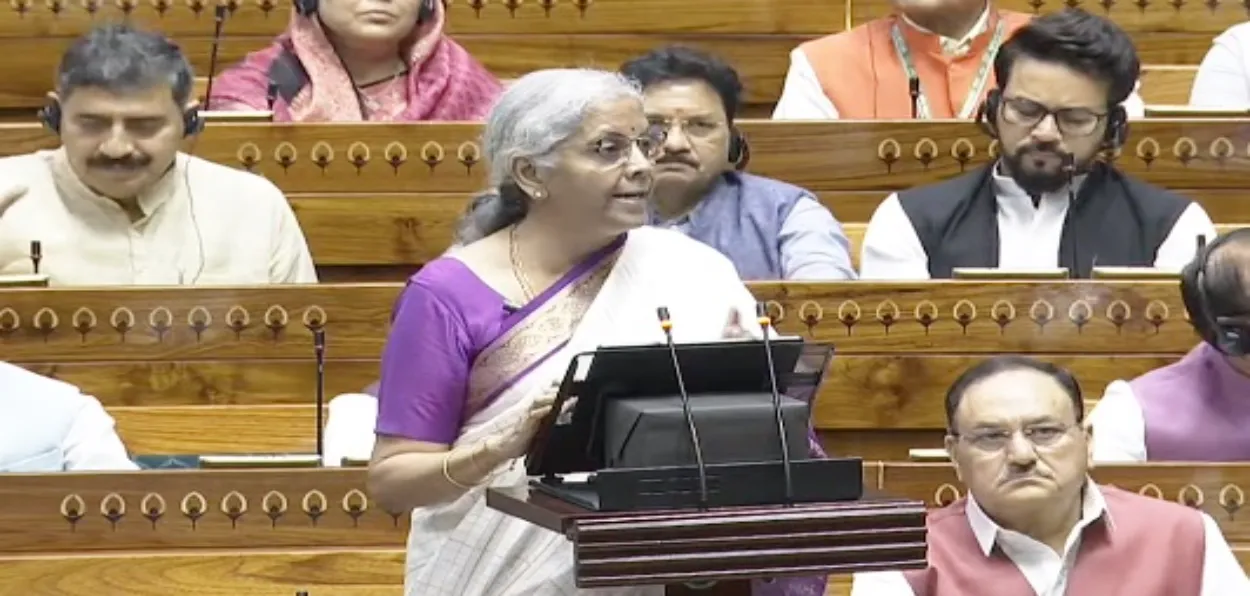


Finanace Minister Nirmala Sitharaman presenting union budget in Parliamente in the Lok Sabha elections
New Delhi
On Tuesday, Union Finance Minister Nirmala Sitharaman presented her seventh straight Budget that would lay a roadmap for ‘Viksit Bharat’ by 2047, focusing on employment, skilling, agriculture, and manufacturing.
The first budget under Modi 3.0 seeks an economic vision that balances fiscal prudence. This is Prime Minister Narendra Modi government’s 13th straight Budget since 2014, including two interim ones
The Union Budget focuses on supporting consumption via higher allocation for the rural economy, taxation reforms, infrastructure push, thrust on local manufacturing, job and skill creation and an increase in production-linked incentive (PLI) allocation to more labour-intensive sectors.
The Finance Minister announced three schemes in a major push to employment generation. “Government to set up three schemes for employment generation. Scheme for first-timers to provide one-month wage to all persons newly entering the workforce in all sectors. First-time employment scheme to benefit 2.1 crore lakh youths,” said the FM.
While presenting the Budget in the Lok Sabha, she said, “People of India have reposed their faith in the government led by PM Modi and re-elected it for a historic third term.”
She said the PM Garib Kalyan Anna Yojana was extended by five years, benefiting more than 80 crore people in the country.
As the Modi government’s focus is the farming community, the Finance Minister said, “New 109 high-yielding, climate-resilient varieties to be released to farmers. One crore farmers are to be initiated into natural farming over two years.”
Other highlights are:
10,000 need-based bio-input centres to be established
Large-scale clusters for vegetable production are to be developed closer to consumption centres.
Digital crop survey for Kharif to be taken up in 400 districts in FY25
Rs 1.52 lakh crore will be set aside for agriculture, and allied sectors in FY25.
In her intial comments, Sithamraman said India’s economic growth will be a shining exception.
“We are determined all Indians regardless of religion and age achieve life goals and aspirations,” Sitharman said.
This would mark Sitharaman’s seventh consecutive budget and eclipses the late Moraji Desai’s record of six consecutive budgets, which is likely to focus on changes in the income tax structure and improving the ease of doing business in India.
Addressing the media, Minister of State for Finance Pankaj Chaudhary earlier said that the first Union Budget of the third Modi government will be based on his mantra of “Sabka Saath Sabka Vikas”.
Union Minister Pralhad Joshi said that this budget would accelerate the country’s economic growth.
“The economic growth that happened under the leadership of Prime Minister Narendra Modi, this budget and this Budget will further accelerate it. The budget that will be presented today by Nirmala ji will also help our country, which is the fastest-growing economy,” Pralhad Joshi said while speaking to the media on the Parliament premises on Tuesday.
The budget session of Parliament began on July 22 and, according to schedule, will end on August 12.
On Monday, the economic survey presented in Parliament by Finance Minister Sithraman emphasized the resilience of the Indian economy and its stable post-Covid recovery.
The Survey underscored the government’s commitment to “Nari Shakti” through various legislative measures and provisions to boost women’s participation in diverse professions.
According to the Economic Survey, the budget for women’s welfare and empowerment schemes has surged by 218.8 percent, growing from Rs 97,134 crore (BE) in FY14 to Rs 3.10 lakh crore in FY25.
Additionally, the Gender Budget Statement (GBS) has seen a 38.7 percent increase compared to FY24 BE, with its share in the total Union Budget rising to 6.5 percent in FY25, the highest since GBS was introduced in FY06.